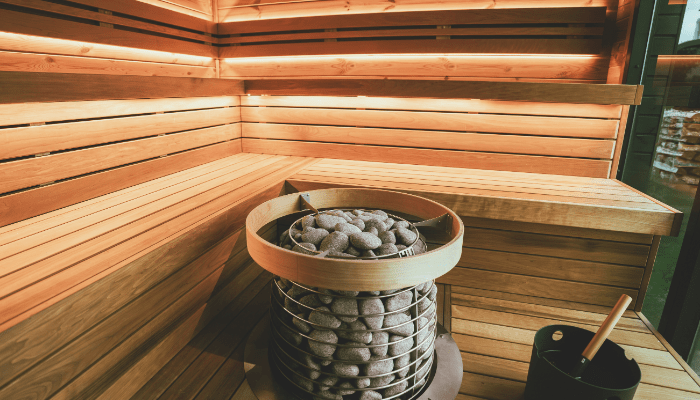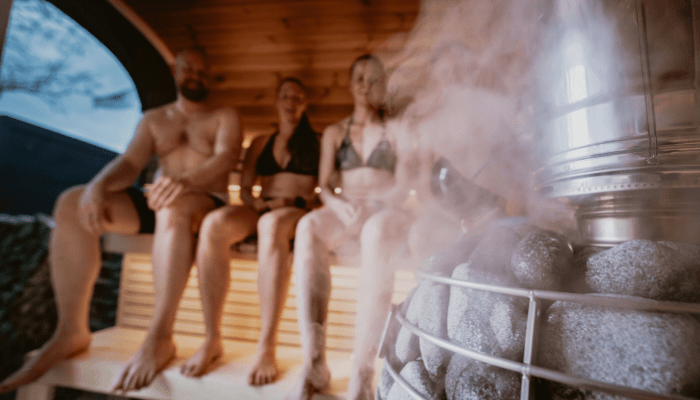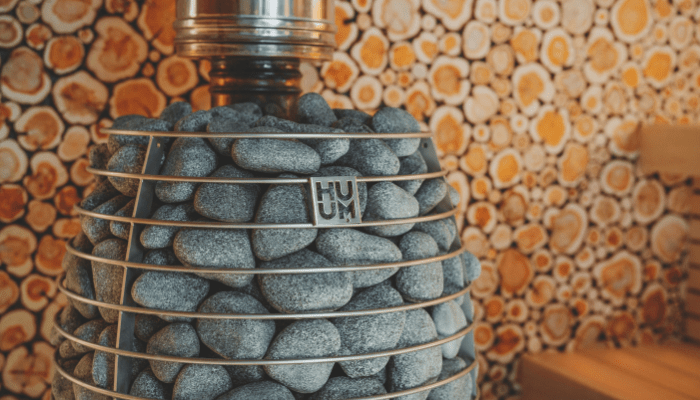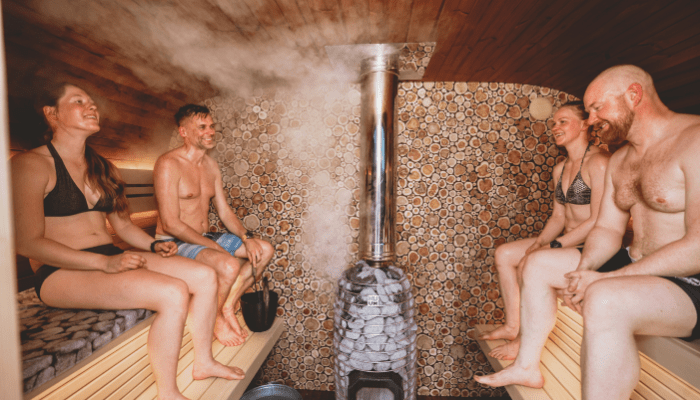Key Takeaways
- Choose sauna wood with low resin, low heat conductivity, and moisture resistance
- Western Red Cedar and Thermo-Aspen are top picks for durability and feel
- Hemlock, Poplar, and Basswood are best for hypoallergenic or infrared builds
- Pine and treated wood are dangerous choices and should be avoided
- Always use kiln-dried wood to prevent warping and cracking
- Match the wood to the type of sauna: traditional, infrared, or outdoor
- Buy from trusted sauna material suppliers for consistent quality

Choose the wrong wood, and your sauna becomes a smokehouse. Choose the right one, and it lasts 20 years, smells like heaven, and doesn’t blister your backside.
Wood is more than a surface in a sauna. It’s the core of the experience. The scent, the feel, the heat, all of it comes down to the material you build with. If you pick the wrong type, you’ll regret it fast. Sticky resin. Overheating benches. Mold. Warping. Funky smells that were definitely not in the brochure.
But here’s the thing: not all wood is created equal when it comes to high-heat, high-moisture environments. And the difference between “luxury spa” and “sweaty garden shed” is usually just a few well-informed decisions during the design phase.
In this guide, we’re cutting through the fluff and walking you through the top woods for sauna construction. Whether you’re building a backyard barrel sauna, an indoor infrared retreat, or retrofitting a spare room, I’ll show you what works, what to avoid, and how to match the right wood to your budget, goals, and location.
Let’s get into the grain of it.
What Makes a Wood Type Good for Saunas?
Before we talk about cedar, spruce, or whatever exotic timber someone on Reddit swears by, let’s start with what sauna wood actually needs to do. It’s not about trendiness. It’s about survival.
Here’s what makes a wood suitable for sauna use:
- Low resin content – You don’t want sap dripping down your back mid-session.
- Dimensional stability – Heat and humidity will test your build. The right wood won’t warp, crack, or shift.
- Low thermal conductivity – Translation: it doesn’t burn your skin when you lean against it.
- Aroma or neutrality – Some woods smell amazing. Others are scentless and hypoallergenic. Either works, just not musty.
- Moisture resistance – Moisture is a given. Mold shouldn’t be.
Basically, you need something that’s comfortable, durable, and safe. Bonus points if it looks great and smells like a forest.
7 Best Types of Wood for Saunas
1. Western Red Cedar
The classic. Red cedar is the go-to wood for a reason. It’s aromatic, naturally insect-resistant, and it looks fantastic. That deep, rich grain makes any sauna feel luxurious.
- Pros: Great smell, excellent durability, soft to touch
- Cons: Expensive, not hypoallergenic
- Best for: Traditional saunas, people who love a strong natural scent
2. Nordic Spruce
It’s clean, light, and widely used in Scandinavian builds. Spruce is stable under heat, but can yellow with time which some people actually like.
- Pros: Affordable, stable, easy to work with
- Cons: May discolor over time, not very aromatic
- Best for: Clean, minimalist designs and Nordic purists
3. Thermo-Aspen (Thermowood)
Thermally modified wood is the engineered superhero of sauna materials. Aspen is heat-treated to resist moisture and warping, all without chemicals.
- Pros: Splinter-free, sustainable, ultra-durable
- Cons: Pricier than untreated wood
- Best for: Interiors, benches, long-term performance
4. Hemlock
Hemlock is popular in commercial infrared saunas because it’s non-aromatic, clean-looking, and durable. Great if you want a neutral experience.
- Pros: Hypoallergenic, affordable, looks sharp
- Cons: No natural scent
- Best for: Infrared saunas, allergy-sensitive users
5. Alder
Often overlooked, but quietly excellent. Alder has a warm tone, resists warping, and ages gracefully.
- Pros: Stable, smooth texture, mid-range price
- Cons: Not as durable as cedar or thermowood
- Best for: Interior walls, anyone avoiding strong scents
6. Basswood
Soft, gentle, and kind to sensitive skin. Basswood doesn’t conduct heat aggressively, so it’s ideal for direct contact.
- Pros: Hypoallergenic, low heat conductivity
- Cons: Soft, can dent easily
- Best for: Infrared saunas, those with chemical sensitivities
7. Poplar
Not fancy, but functional. Poplar is a solid budget-friendly option that handles heat well and won’t off-gas.
- Pros: Neutral scent, low cost, skin-safe
- Cons: Basic appearance, softer wood
- Best for: Budget builds and IR saunas

Woods to Avoid in Saunas
Some woods just aren’t cut out for sauna life. Here’s what to skip:
- Pine – It looks nice, but the resin content is a disaster. Sap leaks when heated. Nobody wants a sticky surprise.
- Pressure-treated or chemically treated wood – Dangerous when heated. These can emit toxins. Keep them away from your skin and lungs.
- Unseasoned or green wood – Will warp, shrink, or crack under heat. Always use kiln-dried lumber.
Sauna Wood Recommendations by Sauna Type
Traditional Finnish Saunas
- Western Red Cedar
- Thermo-Aspen
- Nordic Spruce
Infrared Saunas
- Hemlock
- Basswood
- Poplar
Outdoor Saunas
- Thermowood
- Cedar (if sealed properly)
- Alder (with proper treatment)
Budget Builds
- Poplar
- Spruce
- Alder
Hypoallergenic or Scent-Free Needs
- Hemlock
- Basswood
- Poplar

Best Places to Buy Sauna Wood
If you’re sourcing your own materials, go with trusted sauna suppliers, not the big box store’s random lumber pile. Look for retailers that specialize in kiln-dried sauna woods and understand what makes a species heat-safe.
Some top options include:
- Thermory – Great for Thermo-Aspen and Nordic Spruce
- Finnmark Designs – Excellent for Hemlock and IR builds
- Plunge – Sells sauna wood kits and accessories
- Lunawood – A leader in sustainable Thermowood options
Check if they offer samples touching and smelling the wood can help you decide. Bonus if they offer pre-cut kits to make installation faster.
Conclusion
Choosing the right wood for your sauna isn’t just about looks. It’s about performance, safety, and long-term comfort. Cedar gives you aroma and durability. Thermowood adds next-level stability. Hemlock is clean, subtle, and won’t trigger allergies. Each has its role, if you know what to look for.
And that’s the real takeaway: don’t wing it. Sauna wood isn’t the place to cut corners. You’re dealing with extreme heat, moisture, and human skin. That’s a tough combo.
So, whether you’re going all-in on a custom build or refreshing an old setup, make the wood work for you. Not against you.
Pick smart. Build right. And for the love of sweat, avoid pine.
Inspired by wellness spaces like saunas? We design living landscapes that support relaxation, biodiversity, and year-round beauty with no indoor panels required. Explore our outdoor design services today and book a free call.
FAQ
What is the best wood to use for a sauna?
Cedar is widely considered the best wood for saunas due to its resistance to heat, moisture, and decay. It stays cool to the touch, emits a pleasant aroma, and naturally repels mold and insects. Other good options include hemlock, spruce, and basswood for their stability and low resin content.
Is fir or cedar better for a sauna?
Cedar is generally better than fir for saunas. Cedar resists moisture, doesn’t overheat, and emits a relaxing scent. Fir is more affordable but can warp or crack over time with repeated heat exposure. For durability and comfort, cedar is the preferred choice for both traditional and infrared saunas.
Is hardwood or softwood better for sauna?
Softwood is better than hardwood for saunas. Softwoods like cedar, spruce, or hemlock handle heat and humidity well without becoming too hot to touch. Hardwoods may overheat and cause discomfort. Softwoods also release natural aromas and resist warping, making them ideal for safe, long-lasting sauna construction.



